Key
Innovations and Artists of the Italian Renaissance

I have
superimposed perspective lines illustrating the use of 1-point linear perspective
in "View of an Ideal City", a painting by Piero della Francesca.
The point of convergence is called the vanishing point.
The Italian Renaissance is considered
by historians the beginning of the modern age. The name itself literally means
"rebirth", an accurate description of this period of innovation
in both the sciences and the arts. The literary arts were also given much
attention, as Renaissance thinkers turned to the lost texts of the ancient
world for new understanding. This renewed interest in history, literature,
and the arts was the birth of a whole new way of thinking, one which centered
on the world of mankind as much as a concern for the hereafter (which was
the sole concern of medieval man). This new way of thinking is called humanism,
tracing back to the Greek concept of "man as the measure of all things".
With the invention of movable type during the Renaissance, new ideas and ancient
scholarship spread faster than ever before.
The general dates given for the Renaissance period are 1400-1550, and its
birth-place was unmistakably Florence, a prosperous merchant town in Italy
. It was necessary that the cultivation of great ideas and art would begin
in a center of great wealth... for it required such prosperity to fund the
building of great cathedrals which were elaborately decorated by the best
artists that the region had to offer. Wealthy citizens often donated their
money for specific art commissions, for both religious and secular projects.
The greatest art patrons in Florence were the Medici family, who decorated
their city with sculptures brought from Greece and Rome, commissioned artists
and architects to create, and who also funded the first universities.
The most obvious changes during Renaissance times are seen in the paintings
and sculptures. Though they continued the medieval tradition of using religious
subjects, illustrating stories from the Bible, they combined this interest
with classical ideals of the human figure and an increased interest in depicting
nature. Secular works were also popular, often inspired from Greek and Roman
mythology. Artists began to experiment for the first time with oil-based
paints, mixing powdered pigments with linseed oil (gradually abandoning
the Medieval technique of egg tempera). The paints dried slowly, and
remained workable for a few months. The fresco technique was employed
on plaster walls (reaching perfection with artists such as Michelangelo).
Sculpture began to be conceived "in the round", instead of as relief decorations on cathedrals. Perspective and light were also introduced into
art, perfecting the sense of three-dimensional reality. The artists of the
Renaissance made such a dramatic impact in their concept of space and form
that they have changed the way we look at the world for all time.
The
Early Renaissance: Innovations in Linear Perspective and Human Anatomy
| Giotto (1267-1337) is considered the "Father of the Renaissance".
Characterized as a Proto-Renaissance painter, his work is a transition
from the late medieval (Gothic). His innovations were the use of approximate
perspective, increased volume of figures, and a depth of emotion which
suggests human feeling instead of static and passive icons. |
|
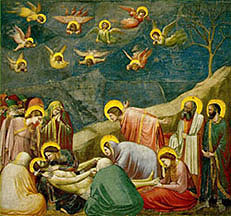
Lamentation of the Death of Christ |
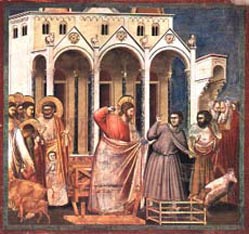
Cleansing of the Temple
|
See more Giotto frescos from the Arena Chapel
Filippo
Brunelleschi (1337-1446) was a Florentine architect and engineer; the first to carry out
a series of optical experiments that led to a mathematical theory of perspective.
Brunelleschi devised the method of perspective for architectural purposes,
but once the method of perspective was published in 1435 (by Alberti), it
would have a dramatic impact on the depiction of 3-dimensional space in the
arts. See perspective illustration at top of page.
Masaccio (1401- 1428) was the one of the first artists to apply the new method
of linear perspective in his fresco of the Holy Trinity. The barrel vaulted ceiling imitates with precision the actual appearance
of the architectural space as it would appear from the viewer's point
of view. His figures are accurate in their description of human anatomy,
influenced by the artist's study of sculpture.
In this painting,
the vanishing point resides below the feet of Jesus. The illusion of
the architecture is so real that one feels as if the wall has been opened
up to reveal the scene. Jesus, the Father, and the Holy Ghost (symbolized
by the dove) are joined by Mary and St.John the Evangelist. Flanked
on the sides are the donors (whose tomb was discovered beneath the mural).
A painted skeleton lies on an illusionary sarcophagus below the inscription:
"What you are, I once was; what I am, you will become".
|
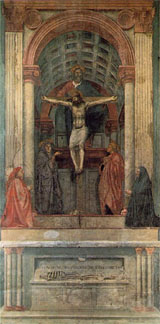
The
Holy Trinity,
fresco
(see enlarged image)
|
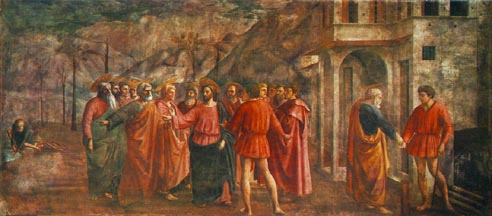 |
Masaccio includes three different moments a the story in
the same scene (a technique known as "continuous narrative"):
At center, Peter asks Jesus why he should have to pay the tax collector's
since his allegiance is only to God and not the Romans. Jesus's response
is to "give to the Romans what is due to them and to the Lord what
is due to Him. He intructs Peter to find the money by going fishing (at
the left, Peter extracts a coin from the fish's mouth); and, to the right,
Peter hands the tribute money to the tax collector in front of his house. |
Piero
della Francesca (1416-1492) was another early Renaissance artist who expressed
an obsession with perspective. His work is characterized by carefully
analyzed architectural spaces, a sensitivity to geometric purity
of shapes, and a sculptural understanding of the figure. He was
so obsessed with perspective and geometry, that he wrote several
treatises on the subject.
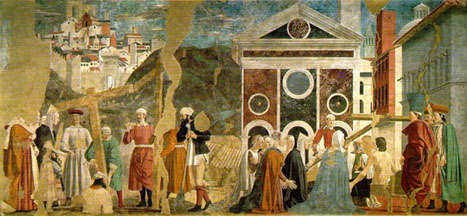
Piero della Francesca, The
Discovery and Proving of the True Cross, fresco, 1452-59
(Web Gallery of Art: http://www.kfki.hu/~arthp)
This is just one of
several murals within a "cycle" depicting the legend of the "true
cross". The cross is discovered with the two crosses (of thieves who
died beside Jesus). The true cross is identified by its power to bring a
dead youth back to life.
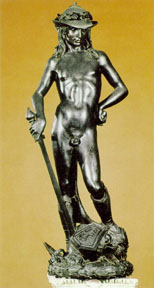
|
Donatello (1386-1466) brought a new sense of naturalism to sculpture. His were some
of the earliest pieces to come off of the walls of cathedrals, occupying
three-dimensional space. His figures use the classical contrapposto stance (relaxed and not rigid). His David is also believed to be
the very first full-scale nude sculpture since ancient times.David is the biblical
youth who conquers the giant, Goliath. Though difficult to see in this
photograph, David stands with his left foot on top of Goliath's head.
It is interesting to compare this sculpture with Michelangelo's later
version.David,
cast bronze (158 cm.), 1444-46
|
Andrea
Mantegna (1430-1506) created unusual vantage points in his paintings, often
looking at figures from below or, in Lamentation Of the Dead Christ,
from the feet of the subject, requiring deep foreshortening.
The position was very effective in placing the viewer at the scene,
adding to one's sense of empathy.
Lamentation
of the Dead Christ, tempera on canvas, 1466
|
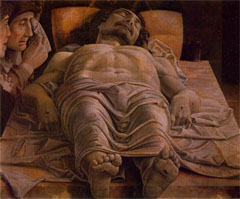
|

Click to View Larger Image of Venus
|
Sandro
Botticelli (1445-1510)
was the first artist to paint a full-length female nude in his Birth
of Venus. The figure actually recalls the exact pose of a Greek sculpture
(the Venus de Medici, which he had access to under their patronage),
though he has added flowing hair and elongated limbs. The figure occupies
the center of the canvas, traditionally reserved only for the subject
of the Virgin. Referring to classical mythology, this is perhaps the most
pagan image of the entire Renaissance. Primavera (Spring) is another
painting of classical subject commissioned for the Medici family.
The
Birth of Venus, tempera on canvas,1485
|
 See Evolution of the Image of the Virgin See Evolution of the Image of the Virgin
to Northern Renaissance
|

